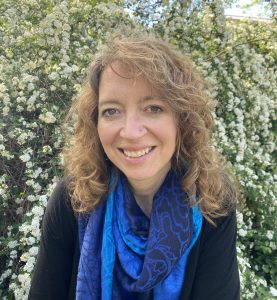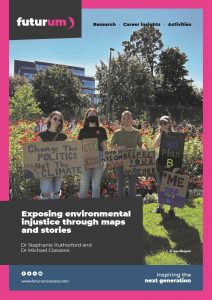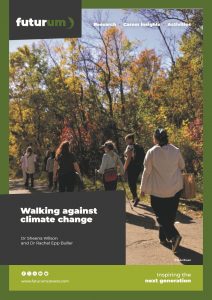Walking against climate change
Many people feel powerless in the fight against climate change. To combat this, Dr Sheena Wilson, from the University of Alberta in Canada, and Dr Rachel Epp Buller, from Bethel College in the US, have developed the ‘Walking the Talk’ project. By encouraging people to go on regular walks in their local area, Rachel and Sheena are helping them to attune to their environment and feel more empowered to create change in their community.
Talk like a climate justice advocate
Attunement — the state of noticing, observing, caring for, paying attention to and building a relationship with something
Climate action — any effort taken to combat climate change and its impacts
Climate injustice — the unequal impacts of climate change on marginalised and vulnerable groups
Climate resilience — the ability to adapt to climate change
Extractivist worldview — the idea that profit can be extracted from people and the planet
Many people who care about the planet feel unconvinced that they can do anything to meaningfully help in the fight against climate change. “The global climate crisis is too big for most people to feel like they can make a difference,” says Dr Rachel Epp Buller, an artist interested in care and connection. “But they can.”
When Rachel moved to Edmonton in Canada, she met Dr Sheena Wilson, an energy humanities researcher who focuses on climate justice and planetary health. “We initially didn’t think our work aligned, as I’m an artist while Sheena has worked on an equitable response to energy transition and climate adaptations,” says Rachel. “But the more we talked, the more we realised we could combine our expertise to create an interdisciplinary project that would achieve more than we could do on our own. The important thing we have in common is our belief that connecting with the place you’re living can help repair the broken relationships that underpin a lot of the problems in the world.”
Rachel went on daily walks to get to know her new local area, and she started to notice how walking led to her feeling more aware of her local environment and community. “So, Sheena and I decided to start a project that uses walking to help people connect with their ‘place’ and to think about that as a climate action in itself,” Rachel explains.
How can walking address the climate crisis?
Rachel and Sheena set up ‘Walking the Talk’ to encourage people to connect with nature by going on regular walks. “We want people to become attuned to the ecosystem around them,” says Sheena. “Once you are aware of something, you care more about it. And once you care, you take action to preserve and protect it.”
The idea is that regular walking helps develop connections, and these connections encourage people to make small, local changes. These walks help people to notice things such as the sounds of their neighbourhood, local plants, effects of weather events and seasonal changes. As well as creating connections with nature, walking regularly builds relationships with people, too. A regular walker might get to know people they pass every day, such as dog walkers. “Connecting with your community in this embodied way is important for building climate resilience,” says Sheena.
Walking to restore
Another idea underpinning ‘Walking the Talk’ is that humanity’s relationship with the planet is destructive, and changing this relationship is key to tackling the climate crisis. “Many climate injustices are due to the extractivist worldview, where resources are taken from the Earth and people for profit,” says Sheena. “In order to heal the world, we need to rebuild relationships and create mutual respect between all communities and between us and the planet.”
Who is walking?
While the project idea was born in Edmonton, Rachel has now taken it to Kansas in the US, where she promotes walking for students and community members. “I give my students a weekly assignment to repeatedly walk on a chosen route, using different prompts each time to encourage them to pay attention to different things,” says Rachel. “I also encourage retired community members, who lead their own walks, to share knowledge with each other about how the environment has changed over the time they’ve lived in the area.” Rachel invites artists and researchers to share their perspectives of walking with the students and community members. “For example, a biologist who studies box turtles talked about how he has to walk at the turtle’s pace to observe them.”
Back in Edmonton, Sheena is organising walks for city employees. “We had a retired city planner lead one walk, who talked about the nature-based solutions he had implemented as a city employee,” says Sheena. “We’ve also had sound artists encourage participants to listen to bird songs and traffic noise pollution, and Indigenous Elders have shared knowledge about plants and the land.” Everyone has a new perspective to share, and many people have volunteered to lead a walk.
Walking towards the future
While the overall goal of the project is to inspire and empower more people to engage in climate action, Rachel and Sheena have specific goals for the different populations they walk with, and they have already started to notice positive changes.
For the undergraduate students, Rachel hopes the walks inspire them to make small and subtle changes as they connect the impacts of their actions to their local area. “Many students who previously drove across campus have started to walk more as a form of transport,” she notes. Additionally, many students have reported an improvement in their well-being, as the walks have given them allocated time in nature away from their screens.
Reference
https://doi.org/10.33424/FUTURUM651
Rachel’s undergraduate students at Bethel College take part in a group walk in Kansas.
© Sheena Wilson
Rachel and Sheena on a winter walk in Edmonton.
© Rachel Epp Buller
For the city employees, Sheena’s project goals are more work-related. “As they are making actionable decisions about the future of Edmonton, we hope they will connect their work decisions to climate change and make different choices for that reason,” she says. Sheena is pleased to see just how many participants have been empowered to lead a walk themselves when they realise how much knowledge they can contribute.
Sheena and Rachel have big hopes for the future of ‘Walking the Talk’. “People often worry that small actions don’t make a difference,” says Sheena. “But by walking with other people and realising that everyone is trying to figure out how to make a difference, we hope people will realise that when lots of people make small changes, it all adds up.”
 Dr Sheena Wilson
Dr Sheena Wilson
Professor of Media, Communications and Cultural Studies, University of Alberta, Canada
Fields of research: Energy-related humanities, climate justice
Website: sheenawilson.ca
 Dr Rachel Epp Buller
Dr Rachel Epp Buller
Professor of Visual Arts and Design, Bethel College, Kansas, USA
Fields of research: Visual art, art history
Website: balance.ddtr.net
Research project: Empowering people to take climate action by connecting with their environment through walking and listening
Funders: Social Sciences and Humanities Research Council of Canada (SSHRC); New Frontiers in Research Fund (NFRF)-International; Kule Institute for Advances Study (KIAS); Lena Waltner Endowment; Milford Greer Endowment
About climate justice
Climate justice is an interdisciplinary concept that connects the climate crisis to the social, racial, political and environmental context that it exists within. While climate change is often thought of as an environmental issue, climate justice considers how the crisis is also a human rights issue, as it is intricately linked to ideas around wealth, capitalism and colonialism. “Climate justice means striving for planetary and community health, healing and well-being,” says Sheena. “It’s about remaking how we live in and interact with the world. The extractivist worldview that drives ‘business-as-usual’ needs to change. Currently, some elites extract value from other people’s labour, lands and communities for profit, rather than for the well-being of everyone. This is a climate injustice. Climate justice starts by making decisions for the well-being of people in our local communities which will lead to planetary health.”
Working in climate justice can come in a variety of forms, and Rachel and Sheena have each come into this work from very different backgrounds. While Rachel is a visual artist looking at care and human connection, Sheena is a humanities researcher interested in sustainability and human rights.
“I always tell my students it doesn’t matter what you’re passionate about – figure out how it links to climate change and climate justice. Because everything does,” says Sheena. “In our walks in Edmonton with city employees, we have urban planners, engineers, hydrologists (who study the movement of water), artists and legal experts coming along. Everyone brings knowledge that can help to address climate injustice.”
Pathway from school to climate justice
To learn more about climate justice, take environmental and sustainability-focused courses that relate to the career path you are interested in. “For example, you could study resource economics, environmental sustainability, energy humanities or sustainable architecture,” says Sheena.
“Don’t be afraid to study in more than one area,” says Rachel. “The world needs well-rounded critical thinkers who can work across disciplines.”
Sheena also recommends studying philosophy. “Philosophy is useful for understanding the logics people use when they think or talk about climate change (or try to deny it),” she says.
“Read widely,” advises Sheena. “Connect your chosen discipline to the social, economic and political histories of human and ecological rights that explain how we got to our current crisis. And be open to what experts from other disciplines, knowledge systems and cultures have to teach you.”
A great way to learn about climate justice is to get involved with a climate or environmental club. Look for local community groups taking action on climate, especially youth-led groups. “Young people have a lot more power than they sometimes realise,” says Sheena.
Explore careers in climate justice
“I believe that everyone should have an understanding of climate justice issues,” says Sheena. “We are all living through a time of global crises and climate change is one of them. It doesn’t matter what career you choose to pursue; you need to be able to link your job to climate change.”
You can get involved with climate justice in small or big ways, from signing a petition to protect nature or joining a local environmental group, to tailoring your career to help populations who are adversely affected by climate change.
Climate justice needs people from all backgrounds. For example, you could work as an engineer developing systems to decrease pollution or manage rising sea-levels, or as an artist helping people to emotionally connect to the environment and take climate action.
Meet Sheena

I came to climate justice through studying human rights. I’m from northern Alberta, where there are significant issues related to the oil sands and the extractivist way in which they are exploited for profit. It’s a human rights issue because lands belonging to Indigenous nations and settler farmers were being destroyed to extract the oil underneath and whole families and communities were being displaced.
Many of my community members and loved ones have worked in the oil industry. Some still do. Early on, I already felt it was unfair how they were represented and targeted by the media. We are all implicated in the oil-industrial complex, so nobody gets to be self-righteous about it. Fossil fuels are deeply embedded in every aspect of society and modern life. We are hypocrites if we target individuals whose livelihoods depend on the oil industry. I felt like it was important to add my voice to the conversation about addressing the human rights and environmental issues of oil sands extraction because I was doing it with love and respect for the people who have found themselves working in this industry to support their families.
I use creative practices to share my research. Stories are a great way to share information as they are the oldest form of knowledge transmission in all cultures. I collaboratively made a documentary film about water extraction from the lakes in Bigstone Cree Nation, and I wrote a story about my son suffering an asthma attack while living in an oil refinery community, which was then turned into a short film called Petro-Mama.
Maintaining relationships and joy is the most important act of resistance in the face of crises such as the climate crisis. Relationships and the small joys of life build and sustain our resilience. Therefore, my research and work are relational.
I live near the Edmonton River Valley, which is the largest urban park in North America, and I love walking there, seeing the plants and listening to the sounds. I’m also a keen gardener and I have loads of plants growing in my small yard. Like walking and being in community, getting your hands in the dirt has physical and mental health benefits.
Meet Rachel

When I was younger, I had diverse interests: making art, playing piano, studying science and writing. I thought I would go to medical school but once I got to university, I found that the arts and humanities were a greater passion for me. That background, though, is maybe why I’ve pursued cross-disciplinary collaborations. There is so much we can learn from each other’s disciplines and ways of doing research.
My professors who were passionate about their subject were a big influence on my career path. Those professors made me want to take more courses in their areas, which is how I ended up with three separate undergraduate majors: studio art, history, and German.
While I am trained as a feminist art historian and a print maker, over time I’ve begun working with a much wider range of materials in a desire to communicate fundamental ideas of care and connection. I’m interested in creating opportunities for connection and bringing attention to the often-invisible labour of relational care.
I believe that listening happens not just with our ears but with our whole bodies – I often use walking as a form of listening. I also explore methods of listening through patterns and traditions of making that we hold in our hands. I am interested in the ways that certain knowledges, such as knitting or stitching or string games, are shared between bodies and often between generations. With these knowledges, speaking and listening with our hands can succeed where words might fail.
While walking in a new place can feel like an adventure, my favourite places to walk are the paths that I have walked many, many times in the places where I have lived. In Kansas, there is a creek that runs near my house, and I walk the path alongside it several times a week. I have walked it so many times that I can walk it in the dark because I know where it rises and falls and where it curves along the water.
Do you have a question for Sheena or Rachel?
Write it in the comments box below and they will get back to you. (Remember, researchers are very busy people, so you may have to wait a few days.)

Discover how researchers and community members are using maps and stories to expose environmental injustices:
futurumcareers.com/exposing-environmental-injustice-through-maps-and-stories












0 Comments